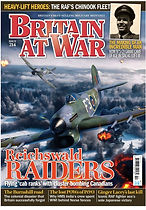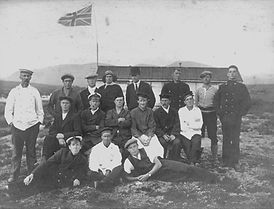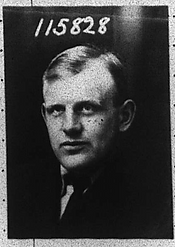Breaking News
This page gives me the chance to update you with all new developments in my research on HMS India. Since submitting my manuscript to be published I have not only found more letters but have made contact with more descendants and researchers. Here is where I will share any news.
Ebay win!
I have had some alerts set on eBay for some time now and the daily emails usually include nothing of interest to me. Two weeks ago, however, a picture flashed up in my inbox and I knew immediately that something of interest had finally cropped up. Below is the image I saw -
New Letter and New contacts
There has been a flurry of activity on the HMS India front over the past week. Firstly there was contact made through this website from the great granddaughter of Able Seaman Elvy Taylor. She provided me with information on Elvy as well as some photos. Then I was contacted by a WW1 collector with news that he had two letters written by Arnold that I had never seen. They were letters full of information and it was great to see them! Finally, I was contacted by the descendants of Felix Clarke, an Able Seaman who perished in the shipwreck of HMS India and whose body was washed up afterwards. He is now buried in Fredriksted Cemetery.

And the next image was -

I immediately recognized Arnold's hand in both images and excitedly tried to get in contact with the seller. After a few days with no reply, I made a bid on the card knowing that it was of little interest to anyone else and that apart from tiny initials in the corner of the drawing of the birds, the work was difficult to attribute to anyone - unless, of course, you have been studying Arnold's work for a few years and know it as well as you know your own writing. Needless to say, I was the only bidder on the card and it is now at home with us and the rest of the collection!
Barbed-Wire Disease
One thing that I am very interested in researching further is Barbed Wire Disease or Sickness. First identified by a Swiss physician, Adolf Lukas Vischer (1884-1974), Barbed Wire Disease (as translated from Vischer's 1918 book Die Stacheldrahkrankheit) identifies the psychological trauma experienced by young men due to enforced captivity in POW and internment camps. Matthew Stibbe, a researcher I am in contact with writes - "Vischer's observations of them (interned men) indicated that those who had been in enemy captivity for extended periods - two years or more - were also suffering from a particular kind of mental illness characterized by disinterest in life beyond camp, restlessness and an inability to concentrate." Stibbe goes on to say "it was not eased or worsened by peculiarities in the educational, class, ethnic or religious background of any particular group of prisoners; rather, its sole cause was the fact of living behind barbed wire itself, and the degree of severity depended primarily on the duration of captivity, not on experiences prior to capture." (Stibbe, M. (2020) 'Barbed-Wire Disease' during the First World War.
www.circulatingnow.nlm.nih.gov.)
As I mentioned, I have made contact with Matthew Stibbe and have shared Arnold's letters with him. I am looking forward to hopefully getting the chance to discuss them and the Jørstadmoen camp in more detail with him.
Britain at War Magazine
February 2025 - Late last year I was invited to write an article about HMS India, the torpedo attack and the internment in Norway by Britain at War magazine. This article has been printed in the February edition which is now on the stands and available on digital platforms as well. It is so exciting to be bringing HMS India and her men's stories to such a large audience and I am hopeful that it will lead to other opportunities for me to share this story. The article and photographs have come up really well and are definitely worth a look!
Podcasts
I had a fantastic time chatting to renowned WW1 historian Paul Reed about HMS India, her men and their internment. As knowledgeable as Paul is, the story of HMS India was completely new to him and he was fascinated in the story and my research into it. We recorded our chat and it will be released on his podcast on 25th November 2025. Click on the link below and it will take you to Paul's website where you can have a listen. Alternatively, The Old Front Line podcast can be found on Apple podcasts and on Spotify.


Sketches
Bill Kennedy, grandson of Commander Kennedy, has let me know that he has some copies he made of the Parson's sketches that are featured on the Torpedo page of the website. He is happy to send them to interested parties for the cost of postage. If you would like to get copies of these sketches - please contact me through the contact page and I will put you in contact with Bill.
My book is published!
I am super excited to announce that my book has been published! It is now available to buy in both printed form and as an e-book. Both formats are available on Amazon and the book itself is now available on line from my publishers - Austin Macauley OR from The Book Depository, Barnes and Noble, Dymocks, Wheelers, Foyles, Waterstones, WH Smith, bookshop.org and on Amazon - https://www.amazon.co.uk/Bare-Chronicle-Existence-Stories-Internment/dp/1398456462/ref=tmm_pap_swatch_0?_encoding=UTF8&qid=1669915431&sr=8-1.
New letters and postcards
I was back in Australia again recently and for the first time had a look at a photo album Arnold had put together of some of his early experiences at sea. Unbeknownst to me, a significant number of the photos were of Jørstadmoen and of his experiences working on the Dovrebanen. Many of the photographs doubled as postcards and so I now have 5 postcards to add to the collection - three to Wilfrid, one to Winnie and one to father.
"
Postcard
?August 19, 1915 to R.F Clarke
Good luck in haste. Can you send some bootlaces, light (weight), literature, some photos and some kreemy (toffee) as an experiment. Weather fine, hockey and golf! á la Harry Lauder sticks. Best love to all, Yrs.
Postcard
January 15, 1916 - 2nd Lieut W. R Clarke
Many thanks for your letter Dec 31 rec’d today. Address changes daily but hope this reaches you. You say ‘again’ in action so I take it you are getting a bit of the real things.
Nothing to report here except the snowfall which increases steadily. 4 feet now, still rising. Is this better than rain? The first case of frostbite occurred recently, but there’s not much danger if you follow out the simple advice. Best wishes and good luck for the New Year.
Postcard
January 29, 1916 - 2nd Lieut W. R Clarke
Another pc to keep us in touch. Absolutely the finest views of the building is the time when we see it for positively the last time. Haven’t heard from home for a month now but time is still passing quickly and it is still snowing. When will you be getting any leave? Good luck. Ever Yrs A
Postcard
March 27th, 1916 - Miss W S Clarke
Judging from the date you went to Camb (Cambridge), you should be home by now; possibly even you would be at Internat v Reservers at Richmond. Here is the usual pc. We had a great disappointment today. One officer had arranged that the ski exercise party instead of dodging around like a jack in the box should go out for a long run 10am till 5pm over a near mountain. Today it dawns and it is thawing and sticky however we’ll practice the jumps this afternoon in hopes. I have very nearly finished “The M’s in a red box,” also some engineering books I have borrowed. ‘Romance’ shews you what you are missing and ‘shop’ books shew you what you should be experiencing and are not. Best wishes.
Postcard
February 4th, 1917 - 2nd Lieut W R Clarke
Please excuse a letter this week but this pc shews you the state of the country here. Snow, snow and ice, it is snowing like blazes at present. Yrs A.
Making Movies
Since first hearing the story of HMS India and then reading Arnold’s letters, I have felt that there was not only a book to be written but also a movie in it. The story seems to have so many areas of interest. It has war and the emotional and personal stories attached to it. There is a torpedo attack and a shipwreck in the treacherous North Sea. There are sad losses but triumphant survivors. There is the heart-breaking decision of what to do with the rescued men and the subsequent interment. But the stories don’t stop there. Once the men are interned there are the positive stories of love, there are amusing scenes of the internees putting on variety nights and dances and sports days. The stories of life inside the camp also include a daring escape, a man’s descent into madness, conflict between guards and interned men and conflict between officers and men. There are also scenes of men building railways in the Norwegian mountains and the stories of them trying to live with Norwegian families. There were men who met the loves of their lives and those who had wartime romances. There were the men who were pining for the women and families that they had left behind. And all of this in the picturesque setting of Gudbrandsdalen valley in Norway.
And the wonderful thing is that not only do we have photographs, formal reports, and word of mouth stories but we also have Arnold’s amazing letters that tell of the smaller details of 39 months of internment. I can see the pictures in my mind however I am no script writer! I have done the years of research but not the specific talent to turn the wealth of information I have into a script. I also have no idea how to find someone to help me! I have no connections in the movie business. So, for now, I will keep plugging my book and trying to get the story told and maybe, just maybe, somewhere along the line, I will meet the right person and Arnold’s and the crew of HMS India’s story will make it to the big screen!


Photo of Elvy Taylor and one of some crew from Elvy's collection
Giving talks
In April I had the opportunity to introduce my book, A Bare Chronicle of Existence, to a new Australian audience. I was thrilled to be invited to give a talk at Martha Point village and it was received by a very appreciative audience. I created a PowerPoint presentation and introduced my audience to Arnold, HMS India, and their story. I included details on the torpedo attack, on life in the camp as well as reading directly from Arnold’s letters. It was gratifying to see the interest on the faces of the audience members and to hear their vocal reactions to some of the more dramatic events in the book. It was also rewarding to spend some time speaking to audience members after the talk. I was excited to sell some more copies of my book! I am looking forward to the next opportunity I have to talk about HMS India and all of the research that I have completed. I love being able to bring this little-known story out to a larger audience.
New letter
I was very excited to be contacted by Bjorn, a gentleman with whom I have had previous conversations about Arnold's letters, regarding a letter he had recently acquired through a philately sale. He was kind enough to scan the letter in for me and has allowed me to share it. Like most philatelists, Bjorn is more interested in the envelope than the accompanying letter. It is a letter I have not seen before and becomes the 81st letter to add to the list of letters that survived the war and i have little doubt that there are more that I have not sighted as they are in private collections. Of the 81 letters, 50 are from the family archives and 31 have been found online or through collectors.
The latest letter is from April 1916 and speaks of trying to get to a church service and the different musical instruments that were being played by the men in the camp. "Much music is now in vogue. The bugles and drums are now our line. There are 2 bangos, 2 mandolins and 'n' one stringed fiddles. Next door, in harmony, a mandoline (sic) and fiddle are getting thro' "True, true till death". Evidently, sentiment at high tide." He also speaks of recent food offerings "We had hot scones for breakfast on Good Friday and shortbread for tea, baked by the ship's baker in our room."
Yet another postcard!
I recently sent a copy of the book to a gentleman who lives only 3 kilometres from the internment camp (which is still an army base). He alerted me to yet another of Arnold's cards which is currently for sale on an auction site! I wonder how many more are out there? The card being auctioned is one of the early ones, written in November 1915 to Nurse Bates. As is typical in the letters he sends to his Nurse, he keeps the conversation fairly light speaking mainly about the environs - "This shews the camp and also the slope we go ski-running and we sometimes go skating on the river in the foreground" and the weather "Frost, snow and sun are ever with us still but it does not take so much to keep warm as you would expect."
Please note that if you are reading this and would like to purchase a signed, dedicated copy of the book, please contact me on the chat button and we can see what we can organize!
Matching faces to names
From the very beginning of this project, I have been eager to find photographs of the sailors in HMS India and, more importantly, to be able to identify the men in the photographs. The twenty or so family members I made contact with whilst researching A Bare Chronicle of Existence were able to provide me with photographs of their ancestors but it has actually been more recently that I have made more inroads into this thread of research. The annotated photo, found in Arnold’s photo album in 2022, which he has annotated with some nicknames of the men featured, added to my list of photographs for faces but it has been in the past couple of weeks that I have been able to add to this list. I discovered that the Merchant Navy records of 1918 had the photographs of each man attached to their records and these are available online. I was able to find files, and therefore photographs, for twenty-nine men who served on HMS India, were interned and then went back to sea as a part of the merchant navy. These official photographs come across as looking very much like mug shots with the often surly expressions and official numbers being clutched on boards between two hands, but they are definitely a look at the men themselves and I can put faces to more names. I now have over fifty visual representations of individual sailors now and hope to keep increasing on that number. I feel that by having photographs of these men then I am really honouring their memory and honouring the experience they went through during WW1. I will keep scouring genealogy sites, old newspaper archives and records to keep trying to find more photographs of these men.







